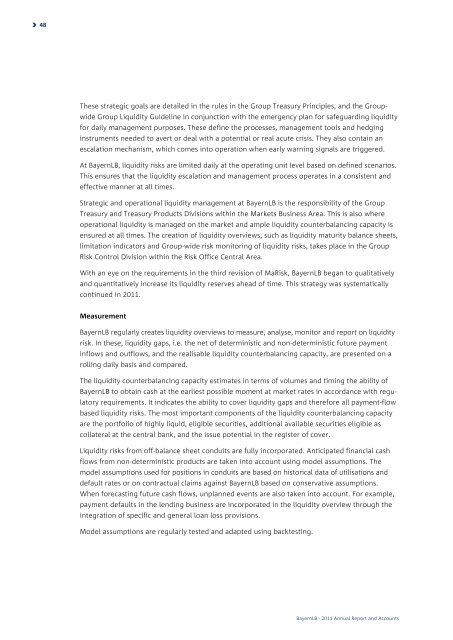Annual Report 2011 (separate financial statements)
Annual Report 2011 (separate financial statements)
Annual Report 2011 (separate financial statements)
Create successful ePaper yourself
Turn your PDF publications into a flip-book with our unique Google optimized e-Paper software.
› 48<br />
These strategic goals are detailed in the rules in the Group Treasury Principles, and the Groupwide<br />
Group Liquidity Guideline in conjunction with the emergency plan for safeguarding liquidity<br />
for daily management purposes. These define the processes, management tools and hedging<br />
instruments needed to avert or deal with a potential or real acute crisis. They also contain an<br />
escalation mechanism, which comes into operation when early warning signals are triggered.<br />
At BayernLB, liquidity risks are limited daily at the operating unit level based on defined scenarios.<br />
This ensures that the liquidity escalation and management process operates in a consistent and<br />
effective manner at all times.<br />
Strategic and operational liquidity management at BayernLB is the responsibility of the Group<br />
Treasury and Treasury Products Divisions within the Markets Business Area. This is also where<br />
operational liquidity is managed on the market and ample liquidity counterbalancing capacity is<br />
ensured at all times. The creation of liquidity overviews, such as liquidity maturity balance sheets,<br />
limitation indicators and Group-wide risk monitoring of liquidity risks, takes place in the Group<br />
Risk Control Division within the Risk Office Central Area.<br />
With an eye on the requirements in the third revision of MaRisk, BayernLB began to qualitatively<br />
and quantitatively increase its liquidity reserves ahead of time. This strategy was systematically<br />
continued in <strong>2011</strong>.<br />
Measurement<br />
BayernLB regularly creates liquidity overviews to measure, analyse, monitor and report on liquidity<br />
risk. In these, liquidity gaps, i.e. the net of deterministic and non-deterministic future payment<br />
inflows and outflows, and the realisable liquidity counterbalancing capacity, are presented on a<br />
rolling daily basis and compared.<br />
The liquidity counterbalancing capacity estimates in terms of volumes and timing the ability of<br />
BayernLB to obtain cash at the earliest possible moment at market rates in accordance with regulatory<br />
requirements. It indicates the ability to cover liquidity gaps and therefore all payment-flow<br />
based liquidity risks. The most important components of the liquidity counterbalancing capacity<br />
are the portfolio of highly liquid, eligible securities, additional available securities eligible as<br />
collateral at the central bank, and the issue potential in the register of cover.<br />
Liquidity risks from off-balance sheet conduits are fully incorporated. Anticipated <strong>financial</strong> cash<br />
flows from non-deterministic products are taken into account using model assumptions. The<br />
model assumptions used for positions in conduits are based on historical data of utilisations and<br />
default rates or on contractual claims against BayernLB based on conservative assumptions.<br />
When forecasting future cash flows, unplanned events are also taken into account. For example,<br />
payment defaults in the lending business are incorporated in the liquidity overview through the<br />
integration of specific and general loan loss provisions.<br />
Model assumptions are regularly tested and adapted using backtesting.<br />
BayernLB . <strong>2011</strong> <strong>Annual</strong> <strong>Report</strong> and Accounts




